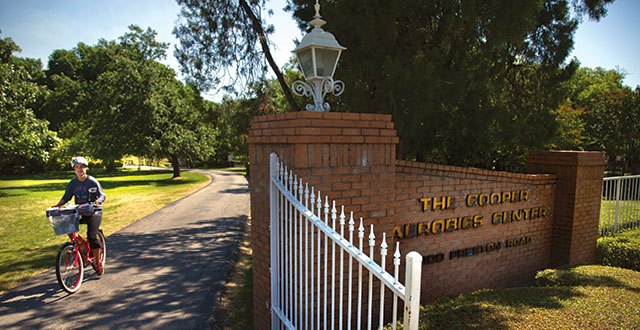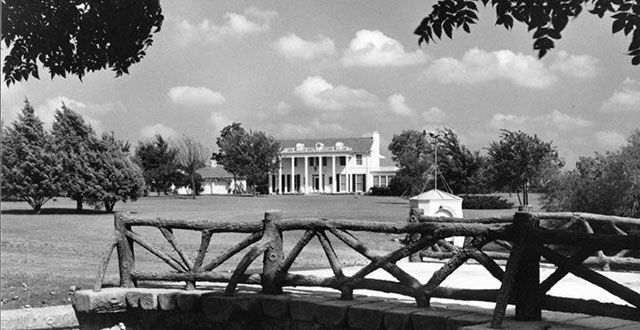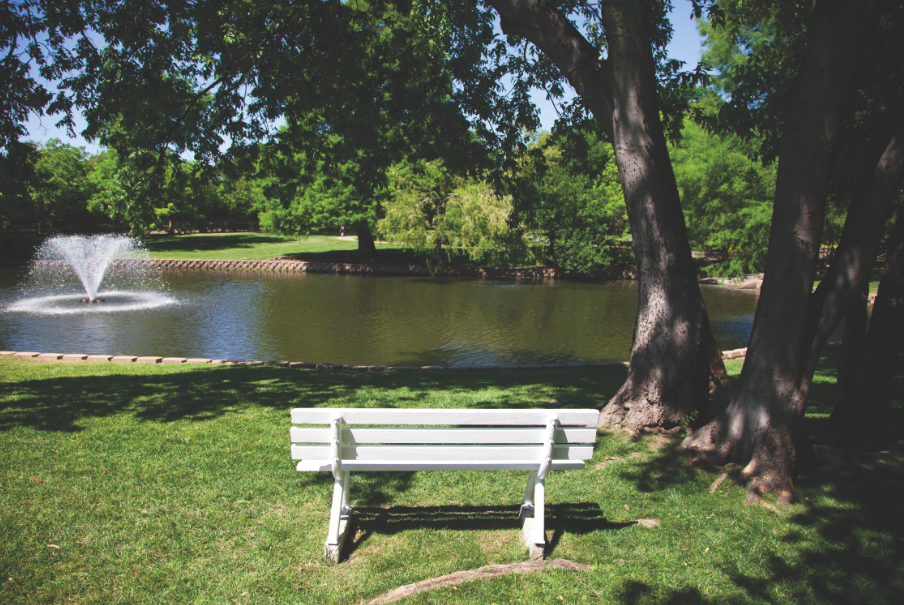
Over the past four decades, the Cooper Aerobics Center has grown to become much more than an unconvential research lab. Photos by Kim Leeson
In the 1940s, a lone brick mansion with white pillars stood on the northeast corner of Preston and Willow, surrounded by acres of cotton fields.
“I remember when my dad planted the crape myrtles and stocked the ponds with perch, largemouth bass and catfish that we’d fish for,” recalls Houston Nichols, the Preston Hollow resident who grew up on the property. “The pond would attract ducks that my mom loved to watch. It was a very park-like setting.”
Today, the same crape myrtles line 30 acres of what has become a global health and wellness institution: the Cooper Aerobics Center.
For 40 years, the world-renowned research lab broke new ground on the significance of aerobic exercise, and it continues to influence changes to lifestyles everywhere. The recent $8.5 million in renovations to the hotel, spa and fitness facilities also have turned the Cooper center into a full-blown health resort.
Houston has watched his childhood home live on through another man’s vision to improve the quality and length of life for its visitors. Houston himself received his first fitness exam at age 22 in what was once his parents’ bedroom.
“It was a thorough exam for the time,” he says, “and I passed.”
A brief history

The Nichols mansion in 1969, shortly before Cooper bought it: Photo courtesy of the Cooper Institute
While serving as an Air Force flight surgeon in the late 1960s, Dr. Kenneth Cooper published his famous book “Aerobics,” traveling the country to promote the value of aerobics to servicemen and women.
Cooper later worked with NASA to determine the fitness of astronauts and prepare them for space travel. He invented the 12-minute and 1.5-mile treadmill stress tests and realized the larger implications of his work. So in 1970, with a 5-year-old daughter and another child on the way, Cooper resigned from the military and opened a small office at Preston and Northwest Highway to further explore the relationship between cardiovascular fitness and longevity.
“I was the first doctor to perform stress tests in Dallas, so people were skeptical of me at first,” Cooper says. “Some even said that the treadmill testing was going to kill people.”
A prominent neighborhood pastor at the time took the stress test, and Cooper was alarmed by the results.
“I told him that he needed to go to the hospital immediately. He didn’t believe me. Sadly, 10 days later he died from a heart attack. After that people started to take me more seriously.”
The next year, Cooper pursued the Nichols family about purchasing their property at Preston and Willow to establish a research center.
Houston’s mother, Clarice, initially turned down his request. But then she recalled his speech at a conference about cardiovascular health. Cooper’s words — and the recent and unexpected loss of her husband from heart disease at age 57 — hit a nerve.
“We all knew how much it meant to Mom,” Houston says. “Plus, Dr. Cooper’s research was not only of interest to us, but we knew that it would be good for Dallas.”
As the Dallas real estate boom spurred rapid growth in the north, the Nichols family could have made considerably more money selling to apartment and townhome developers. But Clarice chose to sell to Cooper — with the conditions that the mansion would always remain intact and that the ducks that frequented the property’s pond could stay.
Cooper agreed.
A hard sell
Cooper had the Nicholses’ blessing, but the general public remained so unconvinced about the legitimacy of aerobics that no bank would approve a loan for Cooper to buy the property.
“We almost went back to the Air Force because it was so hard to secure a $1 million loan,” Cooper says. “It’s an act of God that we’re still here.”
Eventually he found a lender in a steel and pipe company, The Tyler Corporation. The benevolence so moved Cooper that he and his wife named their second child after the company.
Cooper converted the mansion into the Cooper Institute on the second floor and the Cooper Clinic on the first floor. His vision, however, extended far beyond that.
Four decades of research
It’s hard to imagine that a doctor conducting tests in an old mansion would expand his research to impact a global audience, but Cooper did just that. The clinic and institute expanded into new buildings, resembling a sort of “Cooper Compound.”
In 1983 and 1987, two hotel buildings were erected to accommodate out-of-town guests traveling to the clinic for Cooper’s expertise.
“With other doctors’ treatment, it is often too little, too late,” Cooper says. “My focus with all of this is on preventing disease, and if we can’t do that, then we diagnose disease early.”
Dr. Laura DeFina, CEO of the Cooper Institute, says the Cooper Institute accomplishes this by studying information on about 110,000 patients who have visited the clinic and agreed to have their health records used for clinical research, contributing to one of the largest research databases in the world.
The Cooper Institute has used the data for roughly 600 published studies. One of those studies, published in September 2012, correlated midlife fitness with fewer incidences of chronic conditions such as heart disease, Alzheimer’s and diabetes later in life. Researchers compared treadmill stress test results of 18,670 middle-aged patients with their Medicare claims about 20 years later. Patients who performed at a higher level of fitness on the initial test had a lower incidence of Medicare claims.
“I wish that we could push a button to get people to make healthier choices and improve their quality of life,” DeFina says, “but the closest we can get to doing that is by publishing scientific studies that make the matter more urgent.”
An unlikely urban oasis
While Cooper Aerobics was founded on research, a new generation of leadership is helping transform the grounds into a health resort. Cooper’s son, Tyler, now president and CEO, oversaw the recent $8.5 million renovations to the hotel and fitness center, which began in 2012.
“Stress can negatively impact quality of life, so we set out to create a facility here that is peaceful,” Tyler says. “It’s quiet and serene here because of the grounds — our gym and clinic look out to either mature trees or the pond, which is lovely. But to create that high-end resort feel that is like a true getaway, it was time for a renovation.”
Because patients travel to the Cooper Clinic from all over the world to receive a comprehensive physical exam — Tyler estimates about one-third of hotel visitors are from outside of Dallas — he wanted to update each of the 61 hotel rooms.
As part of the renovation, the hotel’s conference rooms, corridors and outdoor pool area — which Mrs. Nichols’ ducks still visit on occasion — also are receiving a much-needed refresh.
Tyler says that the new fixtures were inspired by hotels in California where he and his wife vacation. He hopes the renovations will help guests unwind and relax, and attract more local travel.
“It’s a great option for people looking for accommodations in town to have a quiet ‘staycation’ without all of the stress of travel,” he says
Cooper Fitness Center members also are enjoying $7.5 million worth of upgrades completed earlier this year, including new locker rooms, exercise studios and a three-lane indoor track.
Tyler set out to drive up membership, attracting a new generation of members to the workout facility.
“The women’s locker room is my wife’s baby,” Tyler says. “She worked closely with the design group to create a space so appealing that women would prefer it to getting ready at home.”
Tyler says that more renovation plans are in the works, including doubling the size of the spa at the gym. Since the completion of the fitness center updates, membership has increased by 20 percent.
An open gate
Although many of the 3,620 fitness center members have some notoriety in these parts — anchorwoman Clarice Tinsley and former President George W. Bush, along with a handful of NFL legends including Troy Aikman, Daryl Johnston and Roger Staubach — there are plenty of ways for the rest of the community to enjoy the celebrity-worthy perks of Cooper Aerobics, even if they aren’t members of the fitness center.
Tennis classes, spa services and the restaurant, Cedars Woodfire Grill, are just a handful of Cooper’s amenities open to the community.
Tyler says the white gate surrounding the property can be a bit of an obstacle sometimes, giving the appearance of a private country club.
“Just a few weeks ago I spoke with an acquaintance that had no clue that people who aren’t a member of the fitness center can access our facilities,” Tyler says.
Additionally, the hotel hosts a number of cooking classes, health-centered weekend retreats and conferences, often used by corporate groups encouraging employee wellness. Perks for hotel guests include free access to the fitness center.
The Cooper grounds also are a popular wedding venue in the neighborhood. About 15 to 20 weddings take place under outdoor tents by the ponds annually.
Looking to the future
In March Cooper turned 83. He regularly uses the fitness center with his wife, Millie. In the early days she would joke with her husband about his energetic promotion of aerobic activity.
“Millie would say to me, ‘If you don’t stop talking about exercise, I’m going to leave you,’ ” Cooper recalls. “She still keeps me humble today by reminding me to not get carried away by my audience.”
Houston Nichols and his brother, Larry, still live in the neighborhood and continue to frequent the fitness center adjoined to their childhood home.
Houston says he is pleased with the evolution of his family’s Preston Hollow estate.
“Seeing Dr. Kenneth Cooper’s achievements confirms that our decision to sell our family property to him was the right one. And we are grateful for him fulfilling his promise to my Mom to keep the grounds and our home in their original state. And the ducks.”








